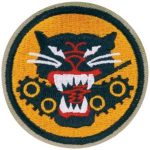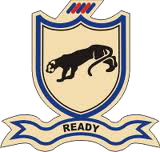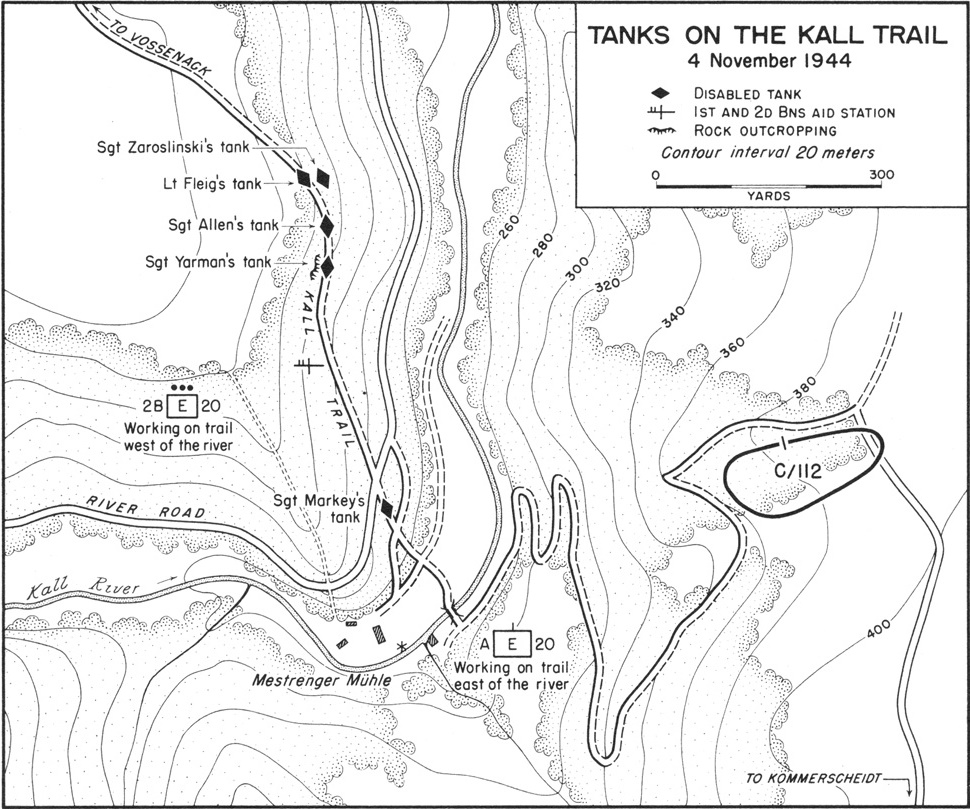As dawn approached on Nov 4, engineer (20-ECB) efforts to improve the trail yielded little. The rock outcropping remained despite numerous attempts at demolition. Weary US infantrymen in Schmidt were still asleep with little thought given to the defenses of their main objective. Only a few AT mines were surface laid on the road leading into Schmidt. Capt Hostrup attempted to move his company again around the outcropping on the morning of Nov 5. The 1st Platoon (Lt Raymond Fleig), led the movement. Just as he managed to maneuver around the outcropping, Fleig’s tank struck a mine. The mine blew the track off and partially blocked the trail. Fleig’s platoon sergeant, S/Sgt Anthony Spooner, suggested winching the other tanks around Fleig’s disabled tank. Using tow cables from the immobilized Sherman, Spooner winched his tank around Fleig’s and back onto the Kall Trail. Fleig hopped onto Spooner’s tank and ordered his platoon sergeant to repeat the winching process with his three remaining tanks. Fleig continued down the narrow trail towards the Kall River.
The German counter-attack against Schmidt started just as Fleig and his tank platoon began their move down the Kall Trail. Led by ten Mark IV and Panther tanks of Oberst Johannes Bayer’s 16.PR (Gen Siegfried Von Waldenburg 116.PD), and elements of the 1055.IR, the German assault smashed into the defenders of Schmidt. The battalion headquarters was quickly overrun with much of the battalion staff and its commander surrendering. Panic-stricken GIs watched as bazooka rounds ricocheted into the air off the thick German armor. Immediately, a stream of GIs headed from Schmidt back to Kommerscheidt. Without tank support, the infantry of the 28-ID had little chance to stop the German assault. Lt Fleig’s remaining three tanks successfully bypassed the outcropping, but Sgt Jack L. Barton’s one threw a track climbing up the far side of the Kall Trail. Fleig and his two tanks took up positions in a shallow draw in an open field just northwest of Kommerscheidt near the Kall wood line. After driving the Americans out of Schmidt, the German attack spilled toward Kommerscheidt.
The Germans did not immediately pursue the fleeing Americans. Instead, German tanks stood out of bazooka range and fired main gun and machine gun rounds into the foxholes of the Kommerscheidt defenders. The Germans then launched an attack against Kommerscheidt with at least eight Mark IV tanks, three Mark V, and approximately two hundred infantry. Fleig immediately maneuvered his tank platoon against the approaching enemy armor. Using the inter-visibility line provided by the lower field they were sitting in, Fleig’s platoon immediately knocked out three Mark IVs.
Fleig noticed GIs retreating from the left side of the town and maneuvered his tank to shore up the now exposed flank. Fleig entered an orchard just in time to see a Panther tank approaching. Fleig fired at a range of 300 yards (275 M), hitting the German twice but with no effect. The Panther crew, frightened by the shell hits, immediately bailed out of their tank and sought cover. Fleig then realized he had fired high-explosive ammunition, not armor-piercing. Worse, Fleig discovered that he had no armor-piercing ammunition inside the tank; all of it was stored outside in the sponson box. Fleig ceased firing and rotated his turret to get at his armor-piercing ammunition. The Panther crew saw Fleig was no longer firing and that their tank was undamaged. They rapidly reboarded their Panther and fired at Fleig, missing high. Fleig and his crew managed to get an AP round into the breech and fired. Luckily for the Americans, their first shot sliced the Panther’s main gun barrel in two. Fleig fired three more AP rounds into the side of the Panther before it caught fire and killed the crew. Fleig and two other tanks would act as roving linebackers throughout the battle, destroying a total of five German tanks and stopping the enemy assault. Their ability to maneuver to the hardest-hit parts of the town prevented the Germans from overrunning it.

 By noon, on Nov 5, an additional Sherman platoon joined Fleig and two platoons of M-10 tank destroyers from the 893-TDB reinforced the defenders of Kommerscheidt. Hampered by the Kall Trail, resupply and reinforcing efforts into Kommerscheidt were extremely limited. The Germans prepared for another assault on Nov 6, led by nine Panthers.
By noon, on Nov 5, an additional Sherman platoon joined Fleig and two platoons of M-10 tank destroyers from the 893-TDB reinforced the defenders of Kommerscheidt. Hampered by the Kall Trail, resupply and reinforcing efforts into Kommerscheidt were extremely limited. The Germans prepared for another assault on Nov 6, led by nine Panthers.
The Germans left their assembly area at 0500, hoping a limited-visibility attack would drive out the defending Americans. Without infantry support, 9 Mark V Panthers, 3 Mark IVs, and 2 Mark V SP-AT guns (Jagdpanthers) began their assault at 0630. The assaulting German company commander reported: at a distance of 150 to 200 meters, the advancing platoon was attacked by enemy tanks, which were well concealed but hampered in their movements between houses and in gardens. Owing to poor visibility and the restricted line of fire, the enemy tanks now attempted to retire from their positions. In doing so, they were destroyed by our tanks, which had taken up ambush positions in the gardens outside the town.
 The defenders uncoordinated efforts resulted in the loss of eight M-10s and eight M-4s. The loss of Kommerscheidt eliminated the chance to recapture the key town of Schmidt. The town would remain in German hands until elements of the 505-PIR (82-A/B) captured it in February 1945. The after-action report of the attacking German company commander at Kommerscheidt highlighted the need for anti-tank combat by two integrated groups cleverly combines the exploitation of friendly firepower and the reactions of the enemy. In addition, he stated, a good interplay of movement and fire must be maintained until the moment of penetration. Although severely limited by the horrible Kall Trail, the American armor that initially reached Kommerscheidt fought a battle of maneuver and defeated the first enemy attack. However, the uncoordinated efforts of the M-4s and M-10s conducting a static defense against a well-coordinated maneuver element in the second attack resulted in defeat for the Americans.
The defenders uncoordinated efforts resulted in the loss of eight M-10s and eight M-4s. The loss of Kommerscheidt eliminated the chance to recapture the key town of Schmidt. The town would remain in German hands until elements of the 505-PIR (82-A/B) captured it in February 1945. The after-action report of the attacking German company commander at Kommerscheidt highlighted the need for anti-tank combat by two integrated groups cleverly combines the exploitation of friendly firepower and the reactions of the enemy. In addition, he stated, a good interplay of movement and fire must be maintained until the moment of penetration. Although severely limited by the horrible Kall Trail, the American armor that initially reached Kommerscheidt fought a battle of maneuver and defeated the first enemy attack. However, the uncoordinated efforts of the M-4s and M-10s conducting a static defense against a well-coordinated maneuver element in the second attack resulted in defeat for the Americans.
CONCLUSIONS
The fighting in the Huertgen Forest was both tragic and unnecessary for the US forces. The terrain was not suited for armor operations and the infantry paid the ultimate price, over twenty-eight thousand casualties. An often forgotten and neglected area of study, the Huertgen Forest still provides lessons on how to use armor in battle and what the results are when it is not used correctly. Denied the chance to fight a maneuver battle, US armor in the Huertgen Forest suffered heavy casualties. In terms of the development of US armor doctrine, the fighting in the Huertgen Forest was a step backward from the significant gains made earlier in the war. Committed piecemeal in the highly unfavorable terrain of the entire area, American tankers faced the same difficulties experienced by British tankers in their early World War I battles. As US armor forces today conduct peacekeeping operations in unfavorable tank country, doctrine writers and armor operators should reexamine the lessons learned from the battle of the Huertgen Forest. Tanks will continue to fight on difficult terrain as long as enemy forces defend that ground. Essential to the combined arms team, tankers must learn how to overcome a harsh battlefield environment to ensure future success.
QUOTED
William Breuer, Death of a Nazi Army (U.S., Scarborough House, 1985)
Bookman & Powers, March to Victory: Guide to WW II Battles and Battlefields from London to the Rhine (New York: Harper and Row, 1988)
Armor – May-June 2002 Gerald Astor, The Bloody Forest (Novato, Calif., Presidio Press, 2000)
489.Division Review, translated by IPW Team 11
Edward Miller, A Dark and Bloody Ground (College Station: Texas A&M University Press, 1995)
Astor, Bloody Forest
S. Hart, German Tanks of World War II (London: Brown Books, 1998)
Chris Ellis, Tanks of World War II (London: Chancellor Press, 1997)
Peter Herrly, Battle of the Huertgen Forest – Battlefield Staff Ride Workbook (REEP, Inc. 1999)
Allyn R. Vannoy and Jay Karamales, Against the Panzers: US Infantry versus German Tanks, 1944-1945, (Jefferson, N.C.: McFarland and Co., Inc., 1996)
Adolf Hohenstein and Wolfgang Trees, Holle Im Huertgen-Wald, (Aachen: Triangle, 1981)
Siegfried von Waldenburg, Report on 116.Panzer-Division (November 1/9 1944), (Historical Division HQs US Army, Europe, 1954)
WORKS CITED
V Corps IPW Team 11. Division Review of the 89.Division: The Battles of Schmidt & Kommerscheidt. November 9, 1944. Translated by IPW Team 11
Astor, Gerald. The Bloody Forest. Novato, Calif. Presidio Press, Inc., 2000
Breuer, William B. Death of a Nazi Army: The Falaise Pocket. US: Scarborough House, 1985
Bookman, John T. & Stephen T. Powers. March to Victory: A Guide to WW-II Battles and Battlefields from London to the Rhine. New York: Harper and Row, 1988
Ellis, Chris. Tanks of World War II. London: Chancellor Press, 1997
The View from the Turret: The 743-TDB During World War II. Shippensburg, Pa: Burd Street Press, 1996
Hart, S. and R. Hart. German Tanks of World War II. London: Brown Books, 1998
Herrly, Peter. Battle of the Huertgen Forest – Battlefield Staff Ride Workbook. Reep, Inc., 1999
Hohenstein, Adolf and Wolfgang Trees. Holle im Huertgen-Wald : Die Kampfe vom Hohen Venn bis zur Rur September 1944 bis Februar 1945. Aachen : Triangle, 1981
Karamales, Jay and Allyn R. Vannoy. Against The Panzers. Jefferson, NC: McFarland & Company, Inc., 1996
Keegan, John. The Second World War. New York: Penguin Books, Ltd., 1989
Landschaftsverband Rheinland. Rheinisches Amt Fur Bodendenkmalpflege. Der Westwall : Vom Denkmalwert des Unerfreulichen. Fuhrer zu archaologischen Denkmalern im Rheinland Nr.2. Koln: Rheinland-Verlag GmbH, 1997
Mahin, LT. Attack Without Artillery. Written by LT Mahian, Seigfried Line Section for Genlt Hans Schmidt, 275.ID CG on Jan 10, 1945.
Miller, Edward. A Dark and Bloody Ground: The Huertgen Forest and the Roer River Dams, 1944-1945. College Station: Texas A&M University Press, 1995
US Army Military History Institute – The Army Air Forces Evaluation Board in The European Theater of Operations. The Effectiveness of Third Phase Tactical Air Operations in the European Theater. Carlisle Barracks, Pa: US Army Military History Institute, 1945
Waldenburg, Seigfried von. 116th Panzer Division (1-9 November 1944). Historical Division Headquarters, United States Army, Europe, 1954
Captain Mike Sullivan was commissioned in the infantry from West Point in 1994. He served as an antitank platoon leader, XO, and rifle platoon leader with 3-505 PIR. After Armor Officer’s Advance Course, he transferred to armor, then served as a Combat Arms Ground Employment controller at the Warrior Preparation Center in Kaiserslautern and deployed to Kosovo for 7 months as the S3 Air with 1-63 Armor, then as a company commander, A/1-63 Armor. Currently, he commands HHC, 1-63 Armor. Captain Sullivan conducts Military Heritage Tours on behalf of the USO to both the Huertgen Forest and Bastogne.




















